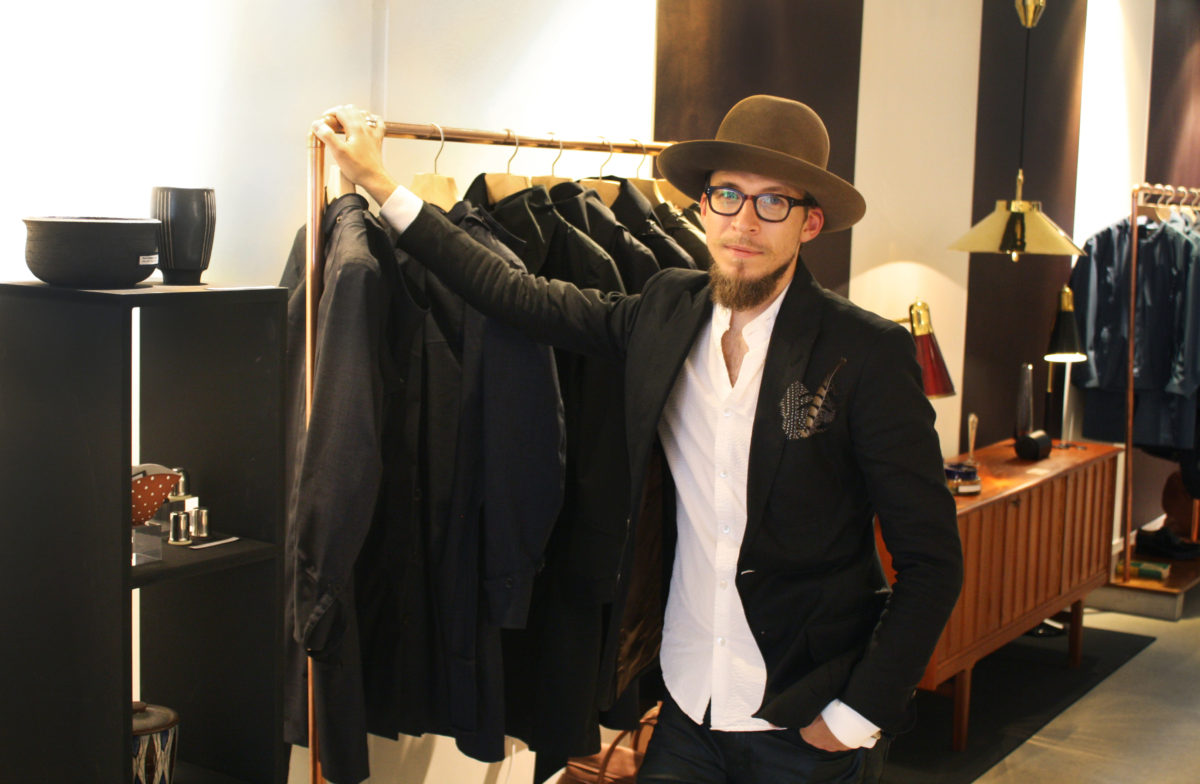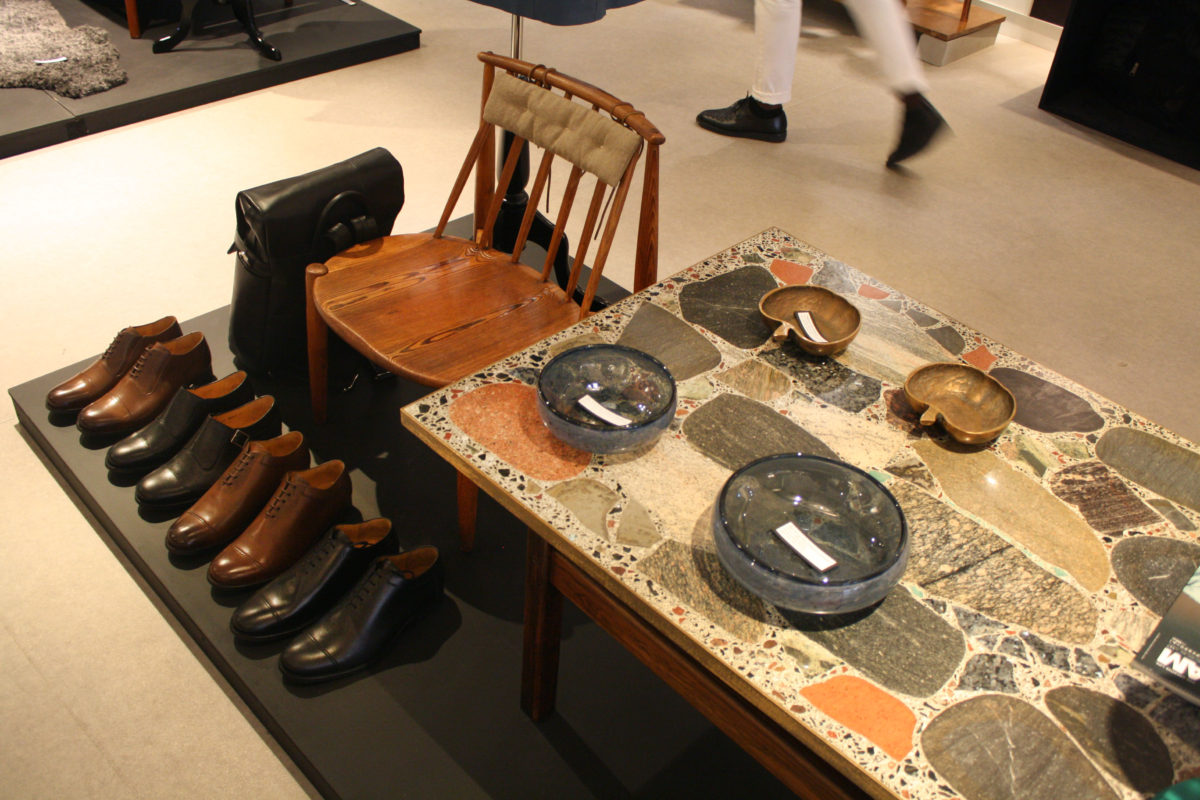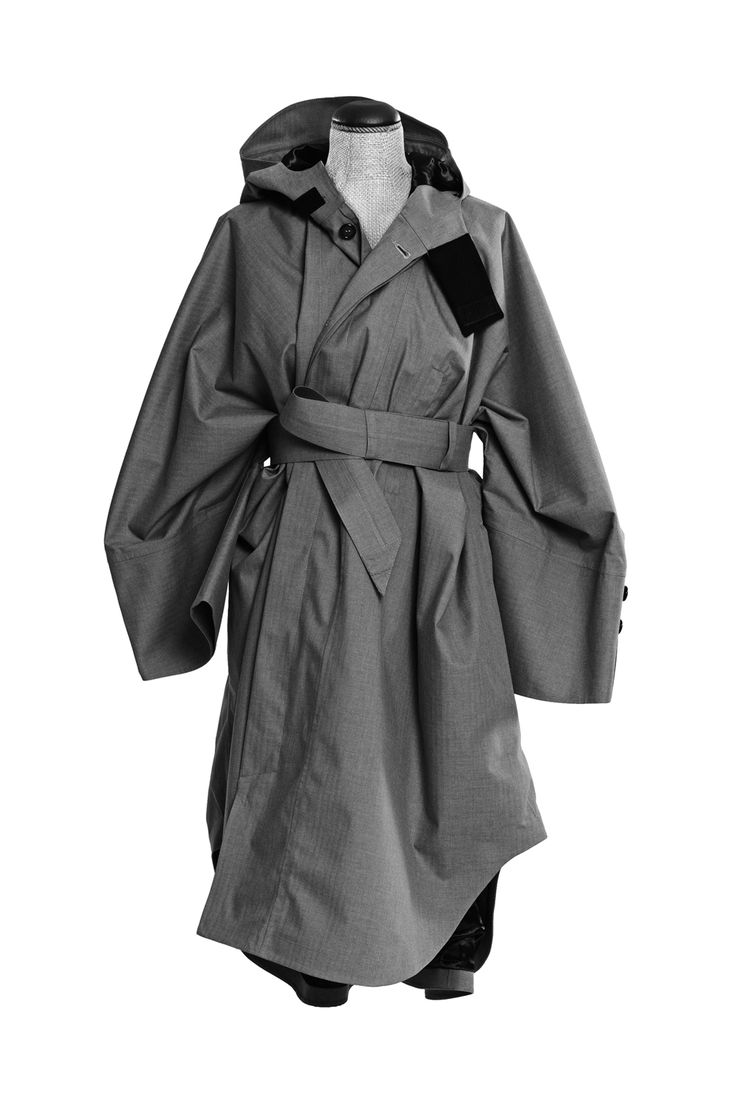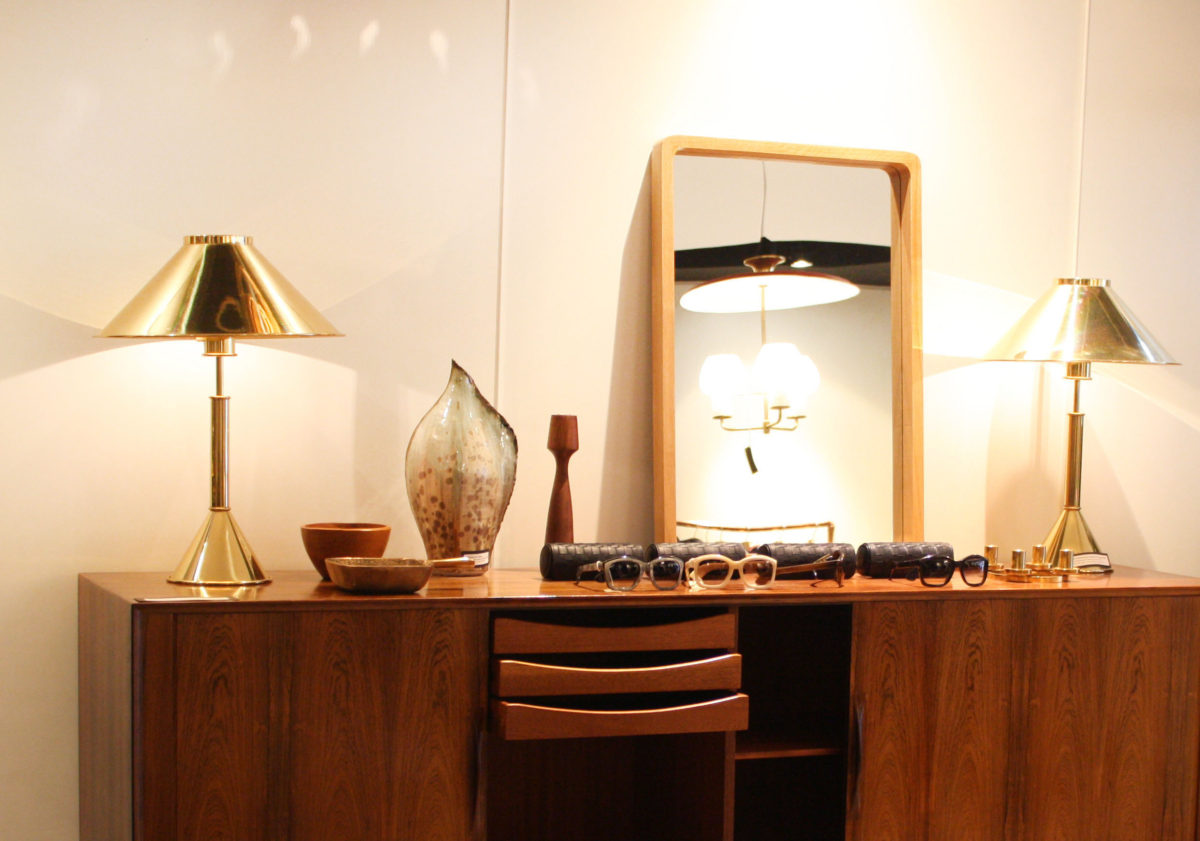Interview: Alexander Helle, Co-founder of Norwegian Rain
By Something CuratedHelmed by creative director Alexander Helle, a business graduate and functionalist, and designer T-Michael, known for his conceptual approach to tailoring, Norwegian Rain creates expertly constructed garments that conceal some of the highest level of weather protection available. Originating from Bergen, Norway, where the brand has two stores, Norwegian Rain has recently launched their first outpost abroad, choosing London’s Piccadilly as their site. Alongside the brand’s signature waterproof garments, the flagship also carries T-Michael’s independent tailoring line, and vintage Scandinavian furniture from Oslo-based retailer, Modern Tribute. Something Curated spoke with the label’s co-founder, Alexander Helle, about the vision behind the brand, the importance of optimism, future collaborations, and the significance of Norwegian Rain’s presence in London.
Something Curated: Tell us about Norwegian Rain, the vision and ethos behind the brand?
Alexander Helle: We are from the rainiest city in Europe, Bergen, it’s a small city surrounded by seven mountains, so all the clouds come in from the UK over the North Sea and become trapped over us – there’s constant rain. When you live in a place where it rains two out of three days, you need to wear functional clothing. But comfort is not just about being dry; it’s also about how you look, how you would like to look. That was the starting point for T-Michael and I when creating the project together. When we tried everything in the market, we found either it looked good but it didn’t breathe, or it did breathe but let in water after a short while – there was always a compromise. When people go to the club they choose their favourite jacket because that’s what they feel most comfortable in, then they come out of the club and it’s pouring and they’re miserable. This has been a challenge we’ve faced when dressing forever, even though the technology to solve this problem exists.
We wanted to have a tailored garment that looked exactly how you wanted, and it should be amongst the most functional coats you have. So if it’s dry it’s perfect and if it rains, it’s a bonus. So you feel comfortable either way. With urban living today, you might begin the day, go to work, then to the café with some friends, or go on a date, then a beer later; you might not be able to keep changing how you dress so we wanted to make pieces that are very versatile. Every detail you see in the garments is there for a reason. Even though it looks like a design detail, it’s hiding something functional. On top of that, you can style the garments in very different ways, strip it back and it’s very classic, or you can use the storm flap and the belts, and the different ways of closing it, to create something rougher. We wanted to make pieces that could be adapted to that kind of life in Nordic climates. That’s how we started.
When we got to the market, the first customers were Japanese actually. And that was fantastic. We knew we’d made a good garment for Bergen but Bergen is small – what about the rest of the world? We were immediately stocked in one of the top stores in Japan, who are still one of our customers. That made us think that this is something the rest of the world needs as well. Now we’re selling all around the world.
SC: I read that the label is based on the longstanding Norwegian tradition of dugnad – could you tell us about the tradition and how it relates to the brand?
AH: Dugnad is a word that describes how a lot of things in our society have been built up in Norway. We have always been a country, before oil, that has been quite a poor nation. So if a fence needed to be built, all the neighbours came out and helped, and if we were making a playground for the neighbourhood children, everyone joined in, some would bring food, we did it together. It’s that kind of spirit that we brought with us. When we created Norwegian Rain, we didn’t have any money, and we knew as soon as we launch the brand, we’d be competing with the rest of the world. Even though we are from a tiny little place in Norway, we still meet all the big brands out there. The world has gone global, and we knew it wasn’t enough to do everything ourselves, we knew we needed to collaborate. We needed to work with the best people we could. Of course, we couldn’t afford that. So we kind of did it the dugnad way, where we invited the people we were inspired by, like the graphic designers in Grandpeople, photographer Bent René Synnevaag, the tailor T-Michael, to all get shares in the company. So it’s the whole team that owns Norwegian Rain. We didn’t take out salaries; that was our creative way of finding a model that worked for us.

SC: What are you currently working on?
AH: This, our first flagship abroad, is of course the most important thing right now – London, at Piccadilly, it’s a major step for us. We have two shops in Norway, and we sell to wholesalers around the world, but this is our first store abroad. We’re extremely excited about that. With the UK, we still haven’t managed to break that retail code. That’s one of the reasons we established the flagship store here. We got fed up of trying to get into one of the good stores and we know, even if you do, you maybe get one rack, and if you fight for it, maybe you get to add something else to show a little bit more of your brand identity. But here we can show the whole universe, which is such a great feeling, and it’s so good for the customers too see what our visions are. Now we’re actually happy it was difficult to break the UK, because now we’re here with our own shop.
In addition to that, Norwegian Rain is doing a collaboration with Grenson Shoes, making a waterproof leather shoe. Then we’re also working on a collaboration with Ally Capellino, another British icon, on a waterproof rucksack. They’re all great people. We’ve got quite a lot of things cooking but we don’t like to talk about it before it’s actually out. It’s better to walk the walk then you can talk.
SC: How are you unique in your approach?
AH: The furniture that you see in the store, it kind of represents our philosophy of how we look at making things. Take for example, let’s not mention brands, in technology, they make things not to last, so you need to upgrade it or buy a new one, which I think is horrible. It’s not good for our environment; it’s just so far from what we love and where our passion lies. This furniture was made in the 50’s and 60’s and they are still more beautiful than most new furniture. They were made to last, and you can see the handcraft, you can see that things have been done that might not have been the most profitable way of doing it but you can see the people actually love what they’ve been doing, and they’ve done it because it excites them and it will excite the person who’s going to have it eventually; this is what we’re trying to do with the coats as well. We want to create your best friend – something that will last. We fuse tradition in the tailoring, and added to that, we have the technology to lift the garments up from what has been done before.
SC: Can you tell us about the dynamic between your collaborator, T-Michael, and yourself?
AH: T-Michael is a tailor and designer, and he has been a tailor for twenty years in Bergen. He grew up in London, originally from Ghana, and then he met a blonde woman from Norway and went with her to Bergen. He has his own brand of suits, shirts, shoes and bags, and then some years ago, I was a big fan, and thinking about this project, I knew that I needed him on board. So I kept going to him and asking if he could join the project. If you go into his shop in Bergen, you see he has all these artefacts and strange things; it’s like a cross between a gallery or museum and a shop. There are things you don’t expect to be there. He’s a fantastic tailor but he also has a mind that is different. And that was important when we started thinking about how to make a raincoat that can be better than what all the big giants have already been making.
Our dynamic started out differently to how it is now. Now we’ve found the kind of functional platform for the coats – that is to say, the fabrics, the sealing, the details when it comes to the functions. So now there is much more freedom when it comes to designing the garments. So at this point, he is the main designer and I’m the creative director, so I am involved, but he’s in charge of that process. We started out with him making the first prototype in canvas, of the silhouette. After talking about it, we decided let’s make a single breasted coat, a classic. We made it, stripped it of all it’s details, we tried the fit, worked a lot on the fit, a very product oriented way of making a garment. Then immediately we saw there was a weakness in terms of where water would enter. We started stress testing the tailoring. We made this water tunnel which looks like a design detail, but it’s there because we needed something to stop the water. That’s how we build up the garments – a need, not a vision of design. Anyway, so that is how it evolved, and now he’s more in lead when it comes to the design process. But when it comes to sourcing fabrics, choosing colours, detailing and fitting, we do it together. And also the business side and decorating the space – we do everything together.

SC: In what ways does the London store’s interior design reflect the brand?
AH: Actually, like with coats, we came in here not with a vision of how we wanted the space but it was more like, we saw what was here and thought about how we can make this into our space. Take the details that are already here and enhance what we like and hide away whatever we didn’t. So that was the starting point really. For example, the ceiling was already here from an earlier concept and we didn’t want to tear it out because we felt it added an interesting element but it didn’t fit with how the rest of the space was before. So we toned down other elements, so the ceiling would get the attention, and kind of pull people into the space.
When we see something beautiful, we don’t have to take it away just to make something new. So that’s typically our way of thinking. And same with the garments – if we manage to create something that we think is really really good, we don’t see why would should take it away six months later just because it’s time to create a new trend. Most of the pieces have stayed but we always enhance and adapt them. There’s always something we see or notice that could be a bit better. The single breasted coat has been here since season two, and now we’re on season nine. So we only want to adapt if it’s an improvement, but we always have new fabrics, new colours and styles as well.
SC: We would be interested to learn more about the weather protection technology used in Norwegian Rain garments.
AH: First of all, we spent thousands of hours sourcing the right fabrics and finally ended up with three. We tested them and found there was actually only one that was keeping up everything it promised. Even very known brands within textiles failed the test. We ended up working with these Japanese suppliers that fitted our three necessities – it had to be amongst the most functional fabrics on the market, when it comes to breathability and being waterproof at the same time, it shouldn’t look like it’s functional or waterproof, and it needed to be eco friendly. We’ve been working with them since 2007.

SC: Tell us about some of the most popular garments you sell and why you think they’re so successful.
AH: We have our bestseller which is the single breasted, and then the Raincho has become our signature model. These two are the best selling and I would say the Raincho is the more iconic piece. It’s funny because it’s worn by everyone from hipsters to my aunt, from suit people to hip-hop artists. It’s interesting how people really make it their own. It’s for women and men, and we see couples come and buy it together. It’s a really nice piece. It started out in Bergen, the gateway to the fjords, and every year there are like 200,000 people coming in in cruise ships. It rains a lot and they come unprotected, and put on these see-through plastic ponchos, it looks horrible. But when we looked at it, it is very versatile and functional in a way because it covers whatever you have. We had that as our starting point and went back and forth with it. We thought we can make this into something beautiful. So when we were in Paris, in a café, we got into the right mood and sat down with some napkins and designed the style right there, then went home and tried it. Some people see references to kimonos, others see a ninja in the rain, but our starting point was the simplest of all ponchos – one piece of fabric with a hole for the head, then adapted to create something as functional and delicate as possible – so a very product oriented process.
SC: How did you get into this industry? What was your journey?
AH: I studied business but it was not my intention to be a businessman. I’ve always been very creative and liked working with my hands. Like when I was young, I was sewing a lot, knitting, building things, all sorts. I lost that. So I can’t sew well but I’ve always had that in me and that’s what I like doing. When I was considering to go the design way, I had a lot of friends and was hearing about a lot of these great talents that didn’t really manage to live out their potential because they didn’t know how to handle the business side, which was this black door you didn’t want to open. And this kind of hindered you from getting to the next level. And I really didn’t like that – I really didn’t want someone to tell me, “Oh, it’s beautiful what you do. Keep making things and I’ll take care of the business part.” I didn’t want to be that dependant on someone else.
Business was also a safer route to go, and my parents were pushing that direction as well. I started, it was five years and then suddenly you’re out. After three years I went to Milan as part of my studies and had a chance to reflect a bit on my life again. I realised I’m going to be done soon, it’s just two more years, so I needed to start thinking about what I was going to do with my life. At the metro station one day, I started thinking about what makes me happy, thinking about Bergen, thinking about how rain is actually such an important part of how you feel in Bergen – it can stop you from doing what you want. So I thought, let’s just combine all of these things and I came up with the Norwegian Rain project. I knew as soon as that thought came, I know it sounds stupid, but I just knew this was going to be my life. Normally I spend a lot of time considering issues from all angles. This time I knew it right away.
Then I started thinking, how could I make a living out of that, and what do I need, and then I changed the whole master’s degree in business to be about how to establish Norwegian Rain. I took all the courses to have that as an example, other students worked with that as an example too, and my lecturers became free consultants. One problem was that I couldn’t sew and I needed to have that expertise of tailoring onboard. Then I met Michael and I knew he had what it takes and what I needed. That’s why I just kept coming back to him. He introduced me to the photographer, we managed to attract our first choice of graphic designers, and by coincidence, Wesley Swolfs entered the shop one day, an Antwerp intellectual, who quickly became our commercial director for the international markets. Slowly we created our universe with the most important bricks in-house. Thanks to this amazing bunch of people, a simple idea has turned into a global project.
SC: What does London, particularly Piccadilly, offer you as the site of your business?
AH: Location is so difficult. It’s probably one of the most difficult decisions you have to make when you’re running a fashion brand. Styles you can always adapt next season if it didn’t work but finding a space to stay, there’s a lot of fixed cost involved and you never know until you’ve tried it. So we really thought about a lot of different places in London, considering our customers as well – we have everything from Soho people to Mayfair people, the tourists, and the hard-core fans, but they will find us anywhere. Usually we’re located on a side street, like in Norway we have these kind of hidden locations. But we thought here, in London, nobody else is selling us and we know from our shops in Norway that it’s quite a variety in our target group. That’s why we thought when this chance came up in Piccadilly that it was actually perfect. This came up because the Crown Estate contacted us. They own a lot of the St. James area and they’re buying out all the concepts here that don’t fit with their vision for the future, and then they work strategically to bring in the right concepts, and we were on that list.
SC: What’s a piece of advice you would give to someone eager to setup their own fashion brand?
AH: I have learnt a lot. First of all, I think it’s good to look at the existing best concepts, and how they’re succeeding, but I think you will only succeed if you find your own way. If you’re just looking at someone else, usually they’re doing it better. If you’re starting up from scratch, you don’t have the capacity to compete with them, and it always takes more time and it costs more money than you think. So if you’re simply copycatting or trying to improve someone else’s concept, it’s really difficult. It’s better, I think, to find a need out there that is matched with something you really have a passion for. If you have found this and can team up with someone else who can fill out the spaces you need to create a good brand, then you have a starting point.
Like I said before, you’re immediately competing with everyone. So if you make beautiful clothing but the photography is not so good, or the website isn’t great, it’s not going to work. You get one chance to make a first impression on those people, and that impression sticks for a long time. So one of the key challenges is sourcing the right team, and then finding a creative way of funding it.
There will be so many obstacles on the way, there’s always some bad news, there’s always something. Michael and me are very similar in this respect, and I think that’s what keeps us going, we know that all the obstacles will actually improve us. Always know that if you have something that puts you back it will eventually help you get further up, because you saw it and now you’re much better prepared for what’s out there. Someone placed a large fake order some years back, and luckily we noticed before we shipped it out. Still, it meant that we had produced a huge stock, but that opened up an opportunity for our first popup at Harvey Nichols, which turned out to be a great success. And we couldn’t have done that if we didn’t have all that leftover stock from the fake order. Bad things can always be turned into a positive thing. You need that mentality or else you’ll just be killed by negative thoughts.

SC: Where do you like to stay when you’re in London?
AH: Like everywhere in the world, we use Airbnb. I think it’s a nice way of living because you get in touch with the local culture. In Japan, we stayed in this traditional Japanese house and it gives you much more than a hotel room that’s the same worldwide. We don’t really have a preferred area in London. We’re usually late when booking, and end up living in the strangest corners. We like to explore new areas, so that just adds to the experience.
SC: What’s your favourite place to shop?
AH: Michael and myself, we don’t really shop that much. We make what we need and we have friends that supply the rest. But I like the antique shops on Portobello Road. The street is too busy, but that kind of treasure hunting is something that I’m a great fan of.
SC: Favourite place to eat?
AH: Chinatown, a local Japanese in Soho, or something as simple as Whole Foods – quality ingredients, simple and convenient.
SC: What’s your work outfit of choice?
AH: You see the traces of people I know. The suits and tailoring from T-Michael, the hat from Super Duper Hats, some great friends from Florence. The pants are from Hansen, a concept based on the idea of traditional Sunday best, a bit rougher clothing but with finer cuts. Back in the day you always dressed up on Sunday, but Norway was a poor country so you only had rough materials. But yeah, you rarely see me without a waistcoat, even though you do today strangely enough, and my hat.
Norwegian Rain – 193 Piccadilly, St James’s, London W1J 9EU
Videography by George Welland
Interview and photography by Keshav Anand